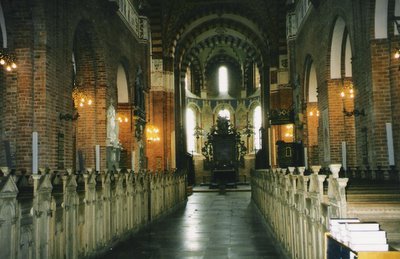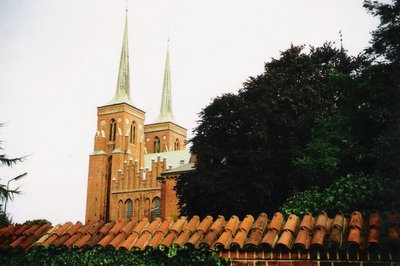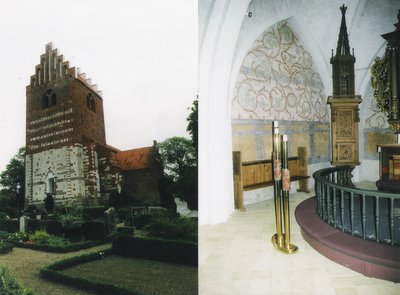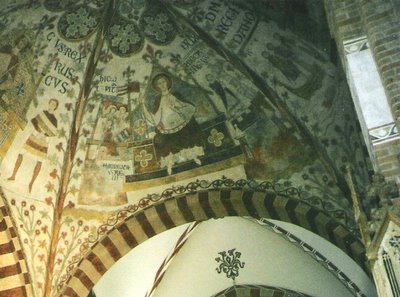Mstislav I of Kiev
1) Christina Ingesdotter of Sweden
2)Liubana Dmitrievna
Mstislav I of Kiev is a rather special link. Through Euphrosyne (his daughter in second marriage) he is an ancestor of King Edward III of England and hence all subsequent English and British monarchs. Through his mother Gytha he is part of a link between Harold II of England and the modern line of English kings founded by William the Conqueror who deposed him.
 |
| Diorama of Kiev c. 1100 |
 |
| Kiev today. |
His full name and title is Mstislav I Vladimirovich the Great, Grand Prince of Kiev from 1125-1132. He was born on June 1, 1076 in Turov and died in Kiev on April 14, 1132. Mstislav was the eldest son of Vladimir II Monomakh by Gytha of Wessex. He is mentioned in the Norse Sagas under the name Harald, taken to allude to his grandfather Harold II of England. Being the eldest son Mstislav was his father's future successor. He reigned in Novgorod from 1088-93 and from 1095-1117. Later he was his father co-ruler in Kiev and inherited the Kievan throne after his death.
 |
| Sct Nicholas, Novgorod |
Mstislav built several churches in Novgorod, Sct. Nicholas cathedral ( 1113) and the cathedral of St. Anthony cloister (1117), both survive to the present day. Sct. Nicholas was situated near his palace at Yaroslav's Court, Novgorod, the church contains 12th century frescoes which illustrates his family. He also built important churches in Kiev, fx.his family sepulchre and the Church of our Lady.
Mstislav was constantly at war from the year 1093 until about 1131, either with the Cumans or the Estonians, the Lithuanians and Polotsk, he also defeated his uncle Oleg of Chernigov, which caused enmity between his and Oleg's descendants. Mstislav was the last ruler of united Rus, and upon his death "the land of Rus was torn apart" - which was said by a chronicler.
There is not much information about his first wife, Christina Ingesdotter of Sweden. She was married to Mstislav in 1095 and she died on January
18 1122. Three years after her death, Mstislav became Grand Prince of
Kiev. Later in 1122 Mstislav married Liubava Dmitrievna, the
daughter of Dmitry Zavidich, a nobleman of Novgorod.
Their children
were: Vladimir III Mstislavich ( 1132-1171) and Euphrosyne of Kiev (c. 1130- c 1193), she married king Geza of Hungary in 1146.
Mstislav and Christina had ten children:
Ingeborg, Malmfred, Eupraxia, Vsevolod, Maria, Iziaslav, Rostislav, Sviatopolk, Rogneda, Xenia.
1. Ingeborg of Kiev
1) Knud Eriksson Lavard)
The first child and eldest daughter
was Ingeborg. She is called Ingeborg of Kiev, Ingeborg of Novgorod or
Ingeborg of Rusland. She married Knud (Lavard), the only legitimate son
of king Erik I Ejegod of Denmark and Bodil Thrugotsdatter. Ingeborg and
Knud had three daugthers and in 1131 they had a son Valdemar, who was
born a week after his father's murder in Haraldsted forest. The boy was
named after his grandfather Vladimir II Monomakh, and this was the first
time the name Valdemar was used in Denmark.
Children:
1. Margaret/Margrethe, married to Stig Hvitaledr (Hvidelæder),
2. Christina/Kirsten (born 1118), married in 1133 to Magnus IV of Norway,
3. Catherine/Katrine, married to Pribislav Henry, duke of Mecklenburg,
4. Valdemar I of Denmark (born 1131).
Please see posts about Ingeborg and Knud Lavard and their daughters elsewhere in this blog.
There is also an article in the Thyra-blog about Knud's murder (search Knud Eriksson Lavard).
2. Malmfred
1) Sigurd I of Norway
2) Erik II Emune of Denmark
Ingeborg's sister Malmfred
was married to king Sigurd I of Norway (Sigurd Jorsalfar) and later to
Erik II Emune of Denmark. She was married to Sigurd between 1116-1120,
he was king of Norway from 1103-1130. In 1098 Sigurd accompanied his
father king Magnus II to the Orkney
Island, Hebrides and the Irish sea. He was made earl of Orkney the same
year. A very young earl. Since he is 14 years old in 1103, he was only 9 years old. It is not certain whether Sigurd
returned home with his father to Norway after the 1098 expedition;
however, it is known that he was in Orkney when Magnus returned west in
1102 for his next expedition. A marriage alliance was
negotiated between Magnus and an Irish princess, and Sigurd was to marry
her sister, princess Blathmin O´Brien. However, when Magnus was
ambushed and killed in Ulaid by an Irish
army in 1103, the 14-year-old Sigurd returned to Norway along with the
rest of the Norwegian army, leaving his child-bride behind, and became
king together with his brothers Øystein and Olav. Upon arriving home
back in Norway, he and his two brothers were proclaimed kings of Norway
and would co-rule the kingdom together for some time. When he married
Malmfred he was ab. 27 years of age. Sigurd died in 1130 and was buried
in Hallvard's church (
Hallvardskirken) in Oslo.
Sigurd
and Malmfred had a daughter, Kristin Sigurdsdatter, (mother of king
Magnus V of Norway) but no legitimate sons. This led
to a power struggle following Sigurd's death between various
illegitimate sons and other royal pretenders, which escalated into a
lengthy and devastating civil war. Tradition say the marriage was
unhappy. Malmfred's husband repudiated her in 1128 and remarried a certain
Cecilia. In 1130 her ex-husband's illegitimate son Magnus IV Sigurdsson
became king and Malmfred left for Denmark, were she married Prince Erik
Emune (king Erik II). In 1131, she arranged the marriage between her
former stepson Magnus IV of Norway to her sister's daughter, princess
Christine of Denmark, (daughter of Ingeborg and Knud Lavard) , they were
married in 1133. Christine's husband king Magnus supported
the struggle of Malmfred, Erik Emune and Christine's father, Knud
Lavard, against
King Niels of Denmark.
In 1133, Erik Emune and Malmfred fled Denmark for Norway and the
protection
of Magnus. After Queen Christine, however, found out that Magnus had
plans to betray them, she warned them and Erik Emune and Malmfred allied
themselwes with the rival of king Magnus, king Harald IV of Norway. King
Magnus then separated from queen Christine. In 1134, Erik Emune became
king, and Malmfred queen of Denmark. She had no more
children. In 1137, her second husband was murdered. Malmfred is not
mentioned after this date.
Malmfred and Sigurd had a daughter: Kristin Sigurdsdatter, she was the wife of Erling Skakke and the mother of king Magnus V of Norway.
3. Eupraxia
1) Alexios Komnenos
Is mentioned as Eupraxia-Dobrodjeja of Kiev in the information about her husband Alexios Komnenos, latinised as Alexius Comnenus, but the identity of his wife is said to be uncertain. It is possible he was married
twice, the first wife being Dobrodjeja Mstislavna of Kiev, (= Eupraxia, which presumably is her Orthodox baptismal name), a daughter of Mstislav of Kiev, and the second being Kata of Georgia, a daughter of David IV of Georgia. While both women are known to have married members of the Komnenoi-family, several theories have been suggested as to the identities of their husband or husbands
.
Alexios
was the eldest son of the Byzantine emperor John II Komnenos and his wife Eirene of Hungary. He was born in February 1106 at Balabista in Macedonia, was made co-emperor with his father at 16 or 17 years of age and died on the 2nd August 1142 at Attalia, Pamphylia. He was an elder brother of the emperor Manuel I Komnenos and had a twin sister, Maria Komnene (plus other siblings).
The coverage of his life is very sparse. Eupraxia died c. 1136.
Alexios Komnenos and his wife (this must be Eupraxia Dobrodjeja had one child:
Maria Komnene (-1167)
 |
| Novgorod (Middle Ages) |
4. Vsevolod of Novgorod and Pskov
1) Chernigovian princess
Vsevolod Mstislavich, the patron saint of the city of Pskov, ruled as Prince of Novgorod in 1117–32, Prince of Pereslavl (1132) and Prince of Pskov in 1137–38. He was the eldest son of Mstislav and Christina. He was born in Novgorod during his father's reign as prince there (1088-93), (1095-1117) and was given the baptismal name Gabriel, or Gavriil. The date of his birth is unknown. He was enthroned as Prince of Novgorod after his father Mistislav became Grand Prince of Kiev in 1117 and ruled Novgorod, with some interruption, until he was ousted by the Novgorodians in 1136. He was married to a Chernigovian princess in Novgorod in 1123 and his son, Ivan, was born there (Ivan died in 1128). Vsevolod died in February 1138. According to his own wishes, he was buried in the Church of St. Demetrius in Pskov.
 |
| frescoes |
Vsevolod built a number of churches in and around the city: the Church
of St. John on Opoki (1127–1130),
the Church of St. George in the Market (1133), the Church of The Assumption in the Market (1133);
and the Church of St. George in the Yuriev Monastery. The Cathedral of St. Nicholas in Yaroslav's Court, while often attributed to his father Mstislav, was mostly built during Vsevolod's tenure in Novgorod.
Vsevolod's comparatively early death prevented him from claiming the Kievan throne. He was survived by a daughter, Wierzchoslawa, the wife of Boleslaw IV the Curly. Prince Vsevolod was canonized by the Russian Orthodox church as Vsevolod-Gavriil. In the Stepennaya Kniga (the "Book of Degrees of Royal Genealogy"), he is listed as a Pskov Wonderworker.
His relics were moved from the Church of St. Demetrius to the Trinity
Cathedral in the Pskov Kremlin in 1193. The Pskovians attached his name
to a German sword with the inscription
honorem meum nemini dabo, formerly preserved in the cathedral sacristy, but modern historians date the sword to the 15th century at the earliest.
Vsevolod married in 1123 in Novgorod a Chernigovian princess who was an unnamed daughter of Svjatoslav Davidovich.
They had two children:
1. Ivan (died 1128),
2. Wierzchoslawa Wsewolodna (ab. 1124- 14 March 1158). She married in 1137 Boleslaw IV the Curly High duke of Poland.
5. Maria
1) Vsevolod II Olgovich
Maria's husband Vsevolod (marriage between 1116-1125) was the prince (Knyaz) of Chernigov (1127-1139) and Grand prince (Velikiy Knyaz) of Kiev 1139-1146, he was a son of Oleg Svyatoslavich, prince of Chernigov. Vsevolod died August 1., 1146. Though he had two sons, Vsevolod's chosen successor was his brother,
Igor, and he obtained pledges from his subjects to accept Igor as his
heir. According to one account, Vsevolod even had the Kievans kiss the
Holy Cross and swear loyalty to Igor, which they resented. Shortly
before his death, Vsevolod became a monk under the name Gavriil. Maria died 1179.
Maria and Vsevolod had two sons and two daughters:
1. Sviatoslav III of Kiev
2
. Yaroslav Vsevolodovich, born in 1139
3. Anna of Chernigov, married a prince of Galicia, according to some chronicles.
4. Zvenislava of Chernigov, married Boleslaw I the Tall, duke of Wroclaw.
6.
Iziaslav II of Kiev
1) Agnes (Liubava) of Germany)
2) Anonymus daughter of Demetrius I of Georgia.
Iziaslav II Mstislavich ( c. 1097-13 november 1154), prince of Pereyslav 1132, prince of Turov 1132-1134, prince of Rostov 1143- , prince of Vladimir and Volyn 1134-1142, Pereyslavl 1143-1145, Grand prince (Velikiy Kniaz) of Kiev 1146-1149 and 1151-1154. He was a son of Mstislav I and Christina of Sweden . His first wife was Agnes, a daughter of king Conrad III of Germany. She took the name Liubava after her marriage. She died in 1151.
Their children were.
1. Mstislav II of Kiev
2. Yaroslav II of Kiev
3. Yaropolk, prince of Shumsk
4. Evdokia, married Mieszko II the Old, High duke of Poland.
Iziaslav's second wife was an anonymous daughter of King Demetrius I of Georgia, but they were married for only a few months in 1154 before his death.
7. Rostislav of Kiev
1) Agnes of Swabia
Rostislav Mstislavich (c. 1110– 14/3-1168), prince (Kniaz) of Smolensk, (1125–1160), Novgorod (1154) and Grand prince (Velikiy kniaz) of Kiev ( (1154, 1159–1167). He was the son of Mstislav I of Kiev and Christina of Sweden. After Yaroslav II of Kiev
was driven out of Novgorod, Rostislav was invited to become the ruler
of Novgorod. He accepted, and became the prince on April 17, 1154. Then,
learning that his brother, Iziaslav II, had died, Rostislav left Novgorod to take the Kievan throne. Indignant that their prince had abandoned them and angered that "
he did not make order among them, but tore them more apart", the citizens of Novgorod drove out Rostislav's son, David, who was their governor. They replaced him with Mstislav Yurievich, the son of Yury Dolgoruky. Rostislav ruled Kiev for one week before Iziaslav III of Kiev forced him to flee to Chernigov. Rostislav was married to Agnes of Swabia (b. ca. 1107 – died ca. 1151) who
gave him five children:
3 sons:
David Rostislavich of Novgorod,
Msitslav Rostislavich of Smolensk
Roman Rostislavich of Kiev
2
daughters
Elena Rostislavna of Kiev-Smolensk (died 1204)
Agrafiya
Rostislavna (died 1237).
8. Sviatopolk of Pskov
1) Euphemia of Moravia.
Sviatopolk, prince of Pskov 1138-40, prince of Novgorod 1142-48, prince of Volynia 1148-54, he died in 1154. He was married between 13/12 1143 and 6/1 1144 to Euphemia of Moravia. She was born 1115, died after 1144.
children:?
9. Rogneda
1) Jaroslav of Turov/Volynia
Rogneda Mstislavna Rurik of Kiev was born circa 1111 to Mstislav I of Kiev and Christina of Sweden. She died c. 1158 of unspecified causes. She married Jaroslav/Yaroslav of Turov/Volynia (c1091-1123).
Children: ?
10. Xenia
1) Briachislav of Izyaslawl
Xenia was the last child of Mstislav and Christina. She married in 1125 Briachislav of Izyaslavl. Xenia died after 1129.
Children: ?
Christine Ingesdotter of Sweden died on January 18, 1122; later that year Mstislav married
again to Liubava Dmitrievna, (+ after 1168) the daughter of Dmitry Zavidich, a
nobleman of Novgorod.
Their children were:
11. Euphrosyne of Kiev (c. 1130- c. 1193)
1) king Geza II of Hungary
Euphrosyne was the eleventh child of Mstislav and the first daughter of Mstislav and his second wife Liubava Dmitrievna. In 1146 Euphrosyne married king Géza II of Hungary, who had come of age shortly before. During her husband's reign Euphrosyne did not intervene in the
politics of the kingdom, but after his death on 31 May 1162, her
influence strengthened over their son, king Stephen III
. The young king had to struggle against his uncles Ladislaus and Stephen to save his throne, and Euphrosyne took an active part in the struggles. She persuaded King Lladislaus II of Bohemia to give military assistance to her son against the invasion of the Emperor Manuel I Komnenos.
Euphrosyne's favourite son was the youngest, Duke Géza of Hungary. When King Stephen III died on 4 March 1172, she was planning to ensure his succession against her older son Béla, who had been living in the court of the Emperor Manuel I Komnenos. However, Béla
came back, and he was crowned on 13 January 1173, although the achbishop Lukács of Esztergom
denied his coronation. Shortly after, King Béla III arrested
his brother, which increased the tension between Euphrosyne and her son. Duke Géza
soon managed to escape, probably with Euphrosyne's help, but in 1177 he was again arrested.
In 1186, Euphrosyne tried to release her younger son again, but she failed. King Béla III
ordered the arrest of Euphrosyne and kept her confined in the fortress of Barancs (Serbian Branicevo). Shortly after, Euphrosyne was set free, but she was obliged to leave the kingdom for Constantinople. From Constantinople she moved to Jerusalem
where she lived as a nun
in the convent
of the Hospitallers, and then in the Basilian monastery of Saint Sabbas.
Euphrosyne and king Géza II of Hungary had following children:
1. king Stephen II of Hungary ( 1147 - 4 march 1172)
2. king Béla III of Hungary (1148 - 23 april 1196)
3 Elisabeth (c 1149 - after 1189) wife of duke Frederick of Bohemia
4. prince Géza (c. 1150 - before 1210)
5. Odola (? )- wife of duke Svatopolk of Bohemia
6. Helena (c. 1158 - 25 May 1199) wife of duke Leopold V of Austria.
Eyuphrosyne is the ancestress of Edward III of England and hence the ancestor of all subsequent English and British monarchs. She is also part of a link connecting the line of Harold Godwinson and the modern line of British monarchs.
12. Vladimir II Mstislavich (1132 - 30/5-1171)
1) daughter of Serbias Belos Vukanovich.
Vladimir III Mstislavich (1132–1173), Prince of Dorogobuzh
(1150–1154, 1170–1171), Vladimir and Volyn
(1154–1157), Slutsk
(1162), Tripolye
(1162–1168) and Grand prince of Kiev (1171). He was the son of Mstislav I of Kiev and his second wife Liubava. Due to his brief rule he is omitted from some lists of the princes of Kiev. He kept excellent ties with Hungary and Serbia. In 1150 he married the daughter of Serbia's Belos Vukanovic. According to old Russian annals, her titular name was enscribed as "Banovna".
children: ?
 Tove, her name carved in runes as ᛏᚢᚠᛅ,
was the daughter of Prince Mistivir/Mistivoj of the Obodrites/ Obotrites,(ab. 990), a region als
known as Wendland. It is not known if she had any children or not. She
is known from the runestone in Sønder Vissing kirke ( in Jutland),
carved in memory of her mother.
Tove, her name carved in runes as ᛏᚢᚠᛅ,
was the daughter of Prince Mistivir/Mistivoj of the Obodrites/ Obotrites,(ab. 990), a region als
known as Wendland. It is not known if she had any children or not. She
is known from the runestone in Sønder Vissing kirke ( in Jutland),
carved in memory of her mother. 




















